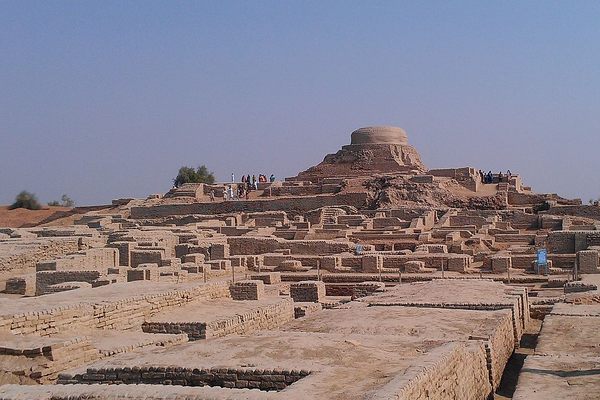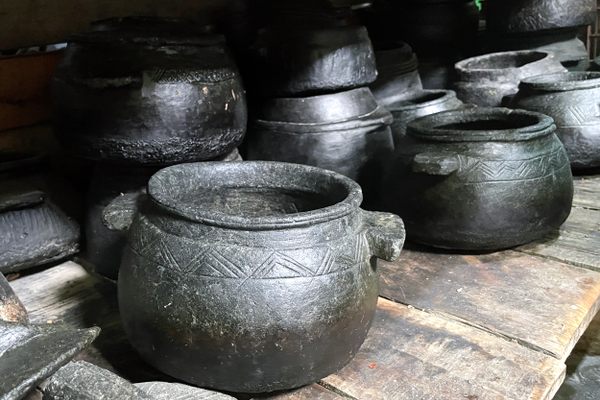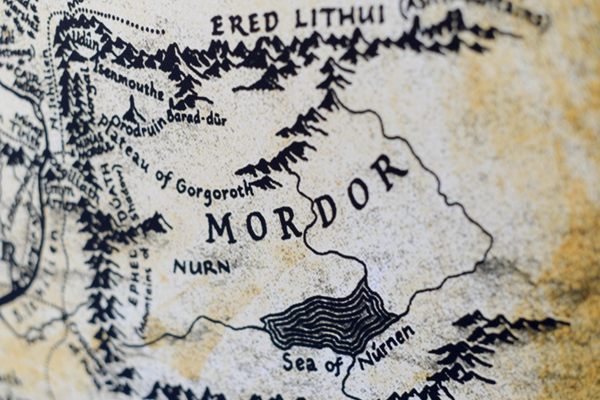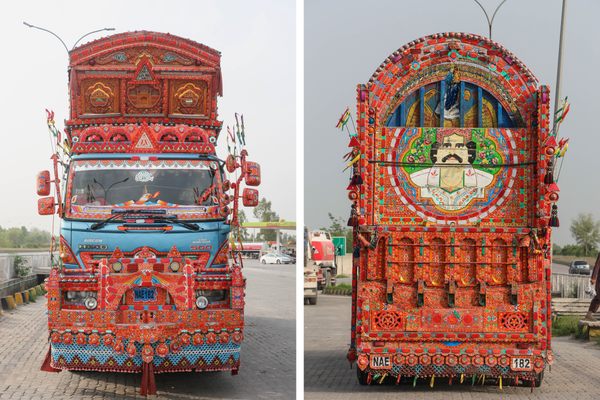In Pakistan, an Inclusive Sikh Festival Highlights History Before Division
Each year, thousands visit the city of Nankana Sahib to commemorate Sikhism’s founder.

“Everyone is equal in Guru Nanak’s eyes,” says Hardial Singh, an Indian Sikh who crossed the border in November to visit Sikhism’s holy sites in Pakistan. Guru Nanak, the founder of Sikhism, “came with a humanitarian mission and everyone is here to serve other pilgrims. The mission of unity is supreme and there is hate for no one.”
In front of the Gurdwara Janam Asthan, a Sikh temple known as the birthplace of Sikhism’s founder, thousands of Sikhs, Muslims, and Hindus gathered in November 2017 to celebrate the 549th birthday of Guru Nanak. The Sikh yatris (pilgrims) faced the center of a sacred pond of water known as the sarovar. Here, more than 500 years ago, a new monotheistic religion took root in South Asia, repudiating the traditional caste system of Hinduism and emphasizing a direct connection to the Divine without priestly intermediaries.

For Singh, whose mother converted to Sikhism from Islam after the violent 1947 Partition that redrew India and Pakistan into two separate states, the legacy of Partition is still alive. “We were children, so we had no understanding. Hate was deeply rooted in the minds of people who were deeply loving of each other before,” he says. During the Partition, Singh’s then-Muslim mother pledged that if she survived Partition, she would donate $100 to Sikh institutions. It was a story that changed Singh’s entire life—soon, he too was bargaining with God, promising to embrace Guru Nanak if he received a pay raise. When his salary more than doubled, he began joining gurdwaras for their communal prayers and meals.

The spiritual teachings of Sikhism were developed by a successive line of Gurus in the 16th century. By the 17th century the faith had gained enough traction that it was seen a potential threat by the Mughals, the preeminent imperial power in the region. Executions of Sikh leaders led the community to become increasingly militarized; by the early 1800s, Ranjit Singh, the first Sikh maharaja (emperor) established Lahore as the seat of the Sikh empire, ruling over an area that is largely resting in modern-day Pakistan. Today, Ranjit Singh is remembered as a ruler who took care to participate in the religious festivals of all residents—regardless of whether they were Hindu, Muslim, or Sikh.
“The reality is that the Sikh empire was a secular empire in which Hindus, Muslims, and Sikhs were equally employed,” says Amardeep Singh, the author of Lost Heritage: The Sikh Legacy in Pakistan.
Gurdwaras, known as ‘gateways to the Gurus,’ have long been known for welcoming diverse groups inside their religious space: “Everybody is the same in this place, and it doesn’t matter what religion they’re from,” says Manohar Lal, a 54-year-old Sikh from India who has been coming to the religious festival in Pakistan annually for 35 years. He notes that Muslims also eat at the langar [communal kitchen].

“It’s an accident of birth which makes us Muslims, Sikhs, and Hindus, and the teachings of Baba Guru Nanak go beyond religious identity or sects,” adds pilgrim Jagtar Singh from Jalandhar, India.
While Partition saw many Sikhs flee the newly created state of Pakistan for India, they left behind numerous gurdwaras. Pakistani Sikhs, who officially number 20,000 countrywide, are often viewed as the guardians upholding the heritage and upkeep of these sites. In recent years, Pashtun Sikhs from Waziristan and the tribal agencies have increasingly begun to resettle in Nankana Sahib after leaving the violence and security deterioration in Pakistan’s other provinces. While ethnic divisions place them outside of the broader Sikh community, their shared religious heritage has eased the integration. For Sikhs in the diaspora, the Pakistani government offers pilgrimage visas to visit religious shrines under a special protocol arranged between the two nations.
Today, more than 500 years later, Sikhs from across the world continue to flock to Pakistan to commemorate the founder of Sikhism’s birth. Since the reduction of violence in recent years, Pakistan’s domestic tourism industry has seen a modest increase in visitors, alongside international religious tourism drawn predominantly from the Sikh diaspora located in India, North America, and Europe. For Sikhs, there remains a strong spiritual legacy in modern-day Pakistan, where 80 percent of the Sikh empire thrived, according to Amardeep Singh.

Behar Lal, a 46-year-old Hindu businessman from Hyderabad, Pakistan was at the festival during the celebrations, honoring Guru Nanak alongside Sikhs. “All of humanity is one. We are all living in one home. Guru Nanak had an idea of unity irrespective of color or creed—he advocated being a human. There might be some visible differences between humans, but the inner self of every human being is connected to someone who is sacred.”
Canadian Sikh Mohanjit Kaur, 43, is on her fifth journey to Pakistan, which she still considers her ancestral home. “My father left Pakistan two days before Partition. We want to be reconnected,” she explains. Her ancestral state of Punjab was split in two by Partition, one side sitting in Pakistan, and the other in India. For Sikhs, the violent division of Punjab is still mourned today, and though Sikhs celebrate their pilgrimage to Guru Nanak’s birthplace, for others, it is a stark reminder that the state of Punjab—marked by a common language, culture, and cuisine—is now severed in two by broader political rivalries between India and Pakistan. For Sikhs like Kaur, there is still nostalgia and yearning for the land located in Pakistan: “We feel more home on this side of Punjab,” Kaur says. During each trip to Pakistan, Kaur has undertaken visits to gurdwaras that are under repair, and has encouraged the government to allow the global Sikh diaspora to fund the restoration of the neglected sites of worship. “If they work with us, we can re-establish Gurdwara Choa Sahib,” Kaur says.

In Pakistan, few modern gurdwaras are constructed by Sikhs; instead, the majority of new gurdwaras are constructed by Pakistan’s Nanakpathi Hindu community, which reveres Guru Nanak. “I believe in Guru Nanak just like Sikhs believe, there is no difference. We read their holy books too. He is the Guru for all,” says 21-year-old Pakistani Hindu student Angili Kumari, who I encounter sitting in front of Gurdwara Janam Asthan’s holy water.
“Guru Nanak believed in equality and never discriminated based on religion,” said a 20-year-old Hindu from Pakistan’s southeastern Sindh province known only as Raveena. “He said everyone is allowed to be part of this festival.”

Some Indian Sikhs like Jaspreet Singh, 30, express a yearning to see Pakistan beyond a circumscribed religious itinerary. “The government of Pakistan should extend the visa to allow us to visit more places in Pakistan, so that we can see what Pakistan is really like,” says the Indian nurse from New Delhi, clad in a turquoise tunic and a black turban. With limited cross-border contact between the South Asian archrivals, tourism offers one avenue to overcome long-seated political tension.
“Pakistan is better than our initial expectations,” says Mejar Singh, a 65-year-old Indian Sikh. “There is no difference between this side of the border and the other. The same type of fields exists on both side. We still belong here, and the people of this Punjab still belong there.”










Follow us on Twitter to get the latest on the world's hidden wonders.
Like us on Facebook to get the latest on the world's hidden wonders.
Follow us on Twitter Like us on Facebook